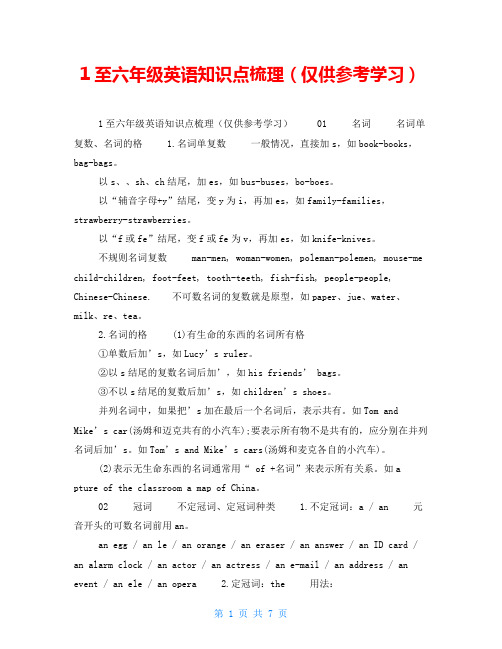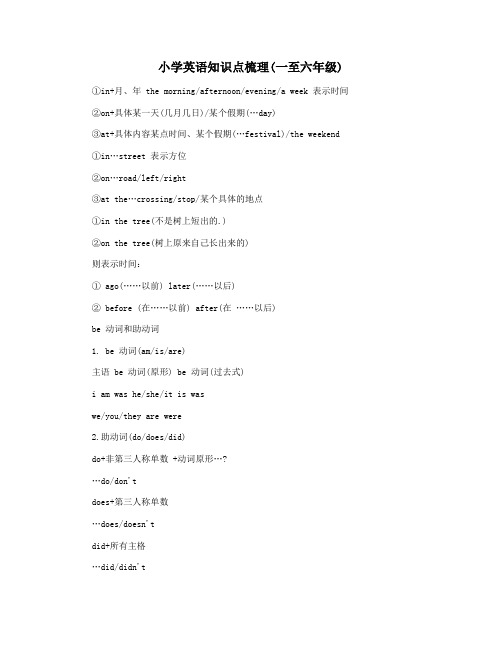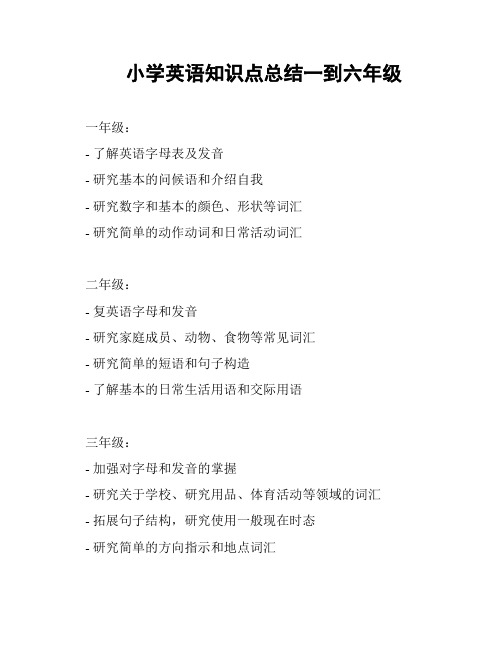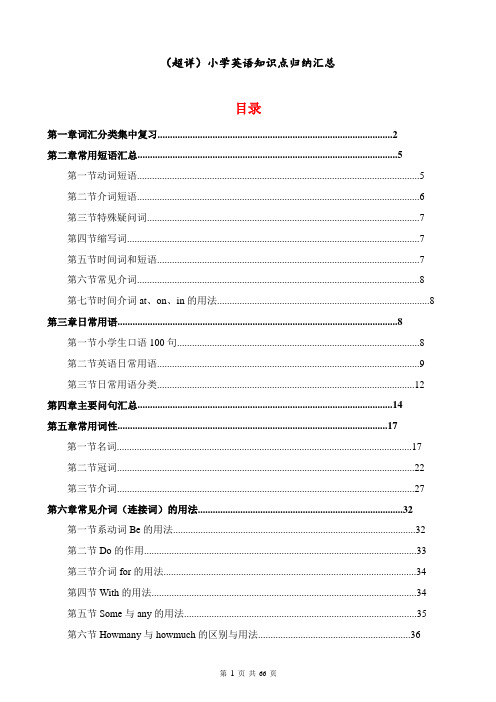1至六年级英语知识点梳理.doc
小学英语1-6年级知识点大全(最全整理)

小学英语1-6年级知识点大全(最全整理)小学英语1-6年级知识点大全(最全整理)!这里是小学阶段必备的英语语法知识点,包括时态、句型、常用词大全等。
多读几遍,记在脑子里哦!1.现在进行时现在进行时表示正在发生的事情或进行的动作,常与now、listen、look等词连用。
结构是主语+be动词(am。
is。
are)+动词ing。
例如:It is raining now.(外面正在下雨。
)It is six o’clock now.(现在6点了。
)XXX.(我父母正在客厅看报纸。
)Look。
The children are having a running race now.(看!孩子们正在赛跑。
)问句将be动词移前,否定句在be动词后+not。
2.一般现在时一般现在时表示经常反复发生的事情或动作,常与often、usually、sometimes、always、every day(week year…) on Sundays等词连用。
结构是主语+动词原形;当主语为第三人称单数即he、she、it、Tom、my mother、the boy等词时,动词后加s或es。
例如:We have an English lesson every day.(我们每天都要上英语课。
)Do the boys run faster than the girls。
Yes。
they do.(男孩比女孩跑的快吗?是的。
)问句借助于do、does,否定句借助于don’t、doesn’t,后面动词一定要还原。
3.一般过去时一般过去时表示发生在过去的事情或存在的状态,常与just now、XXX、… ago、yesterday、last (week、month、year、Monday、weekend)、this morning等词连用。
结构是主语+be动词的过去式(was、were)或主语+动词的过去式。
注意:be动词与动词过去式不可同时使用。
1到6年级英语知识点大全

1到6年级英语知识点大全摘要:一、前言二、小学英语知识点概述1.字母表与发音2.基本单词与词汇3.语法结构4.句型练习5.听力与口语训练6.阅读与写作技巧7.英语歌曲与趣味英语三、一年级英语知识点1.字母表及发音2.简单词汇与句型3.英语歌曲与游戏四、二年级英语知识点1.字母组合及发音2.常用词汇与句型3.英语故事与游戏五、三年级英语知识点1.语法与句型练习2.词汇扩充与阅读3.英语歌曲与趣味英语六、四年级英语知识点1.语法与句型进阶2.词汇与句型运用3.阅读理解与写作技巧七、五年级英语知识点1.词汇与句型拓展2.语法结构巩固3.英语短文阅读与写作八、六年级英语知识点1.句型与语法高级练习2.词汇运用与写作技巧3.英语文章阅读与理解九、总结与展望正文:【前言】英语作为我国义务教育阶段的一门重要学科,从小学阶段开始,孩子们就需要掌握一定的英语基础知识。
为了让孩子们更好地学习英语,本文将详细介绍1 到6 年级英语知识点大全。
【小学英语知识点概述】英语学习是一个循序渐进的过程,从基础的字母表发音到词汇、语法结构、句型练习、听力与口语训练、阅读与写作技巧等方面,孩子们都需要一一掌握。
此外,通过英语歌曲、趣味英语等方法,可以让孩子们在轻松愉快的氛围中学习英语。
【一年级英语知识点】在一年级,孩子们需要掌握字母表及发音,这是英语学习的基础。
此外,简单词汇与句型的学习也是非常重要的,这有助于孩子们在日常生活中进行基本的英语交流。
英语歌曲与游戏可以让孩子们在娱乐中学习,提高学习兴趣。
【二年级英语知识点】随着学习的深入,二年级的孩子们需要掌握字母组合及发音,这将为以后的学习打下坚实的基础。
常用词汇与句型的学习可以让孩子们在英语交流中更加自信。
英语故事与游戏能够丰富孩子们的学习生活,培养他们的英语学习兴趣。
【三年级英语知识点】到了三年级,英语语法与句型练习成为孩子们学习的关键。
此外,词汇扩充与阅读也是非常重要的,这有助于提高孩子们的英语阅读能力。
小学英语1-6年级要点知识点汇总(最全整理)

小学英语1-6年级要点知识点汇总(最全整理)小学1年级英语要点知识点汇总:1. 学习基本的英文字母表和发音;2. 学习基本的问候语和日常用语;3. 学习基本的数字和计数;4. 学习基本的颜色和形状;5. 学习基本的动物和植物名称;6. 学习简单的家庭成员和家居物品的词汇。
小学2年级英语要点知识点汇总:1. 学习基本的人称代词和动词的变化形式;2. 学习基本的食物和饮料的词汇;3. 学习基本的地点和方位的表达;4. 学习基本的天气和季节的词汇;5. 学习基本的学科名称和学校设施的词汇。
小学3年级英语要点知识点汇总:1. 学习基本的时间和日历的表达;2. 学习基本的身体部位和健康的词汇;3. 学习基本的交通工具和旅行的词汇;4. 学习基本的家庭活动和日常生活的词汇;5. 学习基本的国家和国旗的词汇。
小学4年级英语要点知识点汇总:1. 学习基本的动词时态的用法;2. 学习基本的衣物和时尚的词汇;3. 学习基本的节日和庆祝活动的词汇;4. 学习基本的体育活动和运动的词汇;5. 学习基本的科学和自然的词汇。
小学5年级英语要点知识点汇总:1. 学习基本的形容词的用法和比较级、最高级的表达;2. 学习基本的职业和工作的词汇;3. 学习基本的音乐和艺术的词汇;4. 学习基本的地理和地理特点的词汇;5. 学习基本的科技和信息技术的词汇。
小学6年级英语要点知识点汇总:1. 学习基本的副词的用法和修饰方式;2. 学习基本的文学和文化的词汇;3. 学习基本的历史和历史事件的词汇;4. 学习基本的社会和社交活动的词汇;5. 学习基本的环境保护和可持续发展的词汇。
1至六年级英语知识点梳理(仅供参考学习)

1至六年级英语知识点梳理(仅供参考学习)1至六年级英语知识点梳理(仅供参考学习)01 名词名词单复数、名词的格 1.名词单复数一般情况,直接加s,如book-books,bag-bags。
以s、、sh、ch结尾,加es,如bus-buses,bo-boes。
以“辅音字母+y”结尾,变y为i,再加es,如family-families,strawberry-strawberries。
以“f或fe”结尾,变f或fe为v,再加es,如knife-knives。
不规则名词复数man-men, woman-women, poleman-polemen, mouse-me child-children, foot-feet, tooth-teeth, fish-fish, people-people, Chinese-Chinese. 不可数名词的复数就是原型,如paper、jue、water、milk、re、tea。
2.名词的格(1)有生命的东西的名词所有格①单数后加’s,如Lucy’s ruler。
②以s结尾的复数名词后加’,如his f riends’ bags。
③不以s结尾的复数后加’s,如children’s shoes。
并列名词中,如果把’s加在最后一个名词后,表示共有。
如Tom and Mike’s car(汤姆和迈克共有的小汽车);要表示所有物不是共有的,应分别在并列名词后加’s。
如Tom’s and Mike’s cars(汤姆和麦克各自的小汽车)。
(2)表示无生命东西的名词通常用“ of +名词”来表示所有关系。
如apture of the classroom a map of China。
02 冠词不定冠词、定冠词种类 1.不定冠词:a / an 元音开头的可数名词前用an。
an egg / an le / an orange / an eraser / an answer / an ID card / an alarm clock / an actor / an actress / an e-mail / an address / an event / an ele / an opera 2.定冠词:the 用法:特指某(些)人或某(些)物:The ruler is on the desk。
一至六年级英语知识点

一至六年级英语知识点
一、字母和音标:
1. 学习英语字母表,熟悉大小写字母的形状和发音;
2. 掌握英语音标及其对应的发音规则,例如/a:/读作[ɑ:],/i:/
读作[i:]等。
二、基本词汇和日常用语:
1. 学习常用的英语词汇,如数字、颜色、家庭成员等;
2. 掌握基本的日常用语,例如问候语、表达喜欢和不喜欢的情感等。
1. 学习英语句子构成的基本规则,包括主谓宾结构、肯定句和否
定句等;
2. 学习使用一般现在时、一般过去时和一般将来时等基本时态;
3. 学习基本的疑问句和回答方式,例如“Do you like...?”,“Yes, I do.”。
四、日常生活用语:
1. 学习如何表达日常生活中的基本需求,例如购物、问路等;
2. 学习如何用英语描述一些日常活动,例如吃饭、睡觉等。
五、阅读理解:
1. 通过阅读简单的英语文章,提高阅读理解能力;
2. 学会从文章中获取关键信息,回答问题或者判断是否正确。
六、听力与口语:
1. 锻炼听力,通过听取录音或者英语对话,提高听力能力;
2. 练习口语,通过模仿、对话等方式,提高口语表达能力。
以上是一至六年级英语的知识点总结。
希望通过学习这些知识点,同学们能够对英语有一个全面的了解,提高自己的听说读写能力。
记住,多多练习才能够不断进步,英语学习需要坚持和耐心。
希望同学
们能够享受学习英语的过程,取得好成绩!。
1~6年级英语重点知识打印版

1~6年级英语重点知识打印版摘要:一、引言二、一年级英语重点知识三、二年级英语重点知识四、三年级英语重点知识五、四年级英语重点知识六、五年级英语重点知识七、六年级英语重点知识八、总结正文:【引言】在学习英语的过程中,每个年级都有其关键的知识点和重点。
从一年级到六年级,英语学习逐渐由基础语音、词汇、语法向更高难度的知识点拓展。
本文将为您梳理1~6年级英语重点知识,帮助孩子们更好地掌握所学内容,为今后的英语学习打下坚实基础。
【一年级英语重点知识】一年级英语学习重点在于基础语音、字母认识和简单词汇。
学生需要掌握26个字母的发音和书写,以及一些日常简单词汇,如数字、颜色、动物、水果等。
通过学习,孩子们能熟练运用英语进行简单的日常交流。
【二年级英语重点知识】二年级英语学习在一年级基础上,增加了语法和句型的学习。
学生需要掌握一般现在时、一般过去时等基本时态,以及疑问句、祈使句等基本句型。
此外,词汇量也有所扩大,包括家庭、学校、身体部位等日常用语。
【三年级英语重点知识】三年级英语重点在于巩固基础语音、词汇和语法,并开始学习复合句。
学生需要掌握复合句的结构,如主语+谓语+宾语、主语+系动词+表语等。
同时,学习现在进行时、现在完成时等时态。
词汇方面,学生需掌握描述人、物、地点的词汇。
【四年级英语重点知识】四年级英语学习重点在于提高阅读和写作能力。
学生需掌握过去进行时、过去完成时等时态,并在实际应用中运用。
此外,学习被动语态和情态动词,扩大词汇量,涉及更多日常生活、学校生活等方面的词汇。
【五年级英语重点知识】五年级英语学习着重于听、说、读、写四项技能的综合运用。
学生需掌握将来时、将来进行时等时态,并在实际交流中运用。
同时,学习直接引语、间接引语等语法知识。
词汇方面,学生需掌握描述情感、方位、时间的词汇。
【六年级英语重点知识】六年级英语学习重点在于巩固基础知识,提高综合运用能力。
学生需掌握过去完成进行时等时态,学习定语从句、宾语从句等复杂句型。
小学英语1-6年级要点知识点汇总(背熟期末考满分)

小学英语1-6年级要点知识点汇总(背熟期末考满分)第一部分:基础知识1.字母:26个字母的大小写ABCDEFGHIJKLMNOPQRSTUVWXYZabcdefghijklmnopqrstuvwxyz2.语音:元音的发音五个元音字母:AEIOU12个单元音:前元音:[i:] [ɪ] /e/ [æ]中元音:[ɜ:] [ə]后元音:[ɑ:] [ɒ] [ɔ:] [u :] [ʊ] [ʌ]双元音(8个)Ⅰ.合口双元音(5个)[ai] [ei] [au] [əu] [ɔi]Ⅱ.集中双元音(3个)[iə][εə][uə]3.词汇:词汇量,近反义词4.句子:大小写,标点符号第二部分:语法知识(1)一.名词:名词单复数,名词的格(一)名词单复数1.一般情况,直接加-s,如:book-books, bag-bags, cat-cats, bed-beds2.以s. x. sh. ch结尾,加-es,如:bus-buses, box-boxes, brush-brushes, watch-watches3.以“辅音字母+y”结尾,变y为i, 再加-es,如:family-families, strawberry-strawberries4.以“f或fe”结尾,变f或fe为v, 再加-es,如:knife-knives5.不规则名词复数:man-men, woman-women, policeman-policemen, policewoman-policewomen, mouse-mice child-children, foot-feet, tooth-teeth, fish-fish, people-people, Chinese-Chinese, Japanese-Japanese不可数名词的复数就是原型:paper, juice, water, milk, rice, tea(二)名词的格(1) 有生命的东西的名词所有格:a) 单数后加’s 如: Lucy’s ruler my father’s shirtb) 以s 结尾的复数名词后加’如: his friends’bagsc) 不以s 结尾的复数后加’s children’s shoesl并列名词中,如果把’s加在最后一个名词后,表示共有, 如:Tom and Mike’s car 汤姆和迈克共有的小汽车l要表示所有物不是共有的,应分别在并列名词后加’sTom’s and Mike’s cars 汤姆和麦克各自的小汽车(2)表示无生命东西的名词通常用“of +名词”来表示所有关系:如:a picture of the classroom a map of China第二部分:语法知识(2)二.冠词:不定冠词,定冠词种类:(1)不定冠词:a / an a unit / an uncle元音开头的可数名词前用an :an egg / an apple / an orange / an eraser / an answer / an ID card / an alarm clock / an actor / an actress / an e-mail / an address / an event / an example / an opera / an houran old man / an interesting book / an exciting sport / an action movie / an art lesson /(2)定冠词:the the egg the plane2. 用法:定冠词的用法:(1)特指某(些)人或某(些)物:The ruler is on the desk.(2)复述上文提到的人或物:He has a sweater. The sweater is new.(3)谈话双方都知道的人或物:The boys aren’t at school.(4)在序数词前:John’s birthday is February the second.(5)用于固定词组中:in the morning / afternoon / evening不用冠词的情况:(1)专有名词前:China is a big country.(2)名词前有定语:this , that , my , your , some, any , no 等:This is my baseball.(3)复数名词表示一类人和事:Monkeys can’t swim. They are teachers.(4)在节日,日期,月份,季节前:Today is Christmas Day. It’s Sunday.(5)一日三餐前:We have breakfast at 6:30.(6)球类棋类运动前:They often play football after class. He plays chess at home.* 但乐器前要用定冠词:I play the guitar very well.(7)学科名称前:My favorite subject is music.(8)在称呼或头衔的名词前:This is Mr Li.(9)固定词组中:at noon at night by bus第二部分:语法知识(3)三、代词、形容词、副词代词:人称代词,物主代词人称代词物主代词主格宾格第一人称单数I(我)memy(我的)复数we(我们)usour(我们的)第二人称单数you(你)youyour(你的)复数you(你们)youyour(你们的)第三人称单数he(他)himhis(他的)she(她)herher(她的)it(它)itits(它的)复数they(他们/她们/它们)themtheir(他们的/她们的/它们的)形容词,副词:比较级,最高级(一)、形容词的比较级1、形容词比较级在句子中的运用:两个事物或人的比较用比较级,比较级后面一般带有单词than。
一到六年级知识点归纳英语

一到六年级知识点归纳英语一年级知识点。
一、字母。
1. 认识26个英文字母的大小写形式,能正确区分和书写。
例如:Aa, Bb, Cc 等。
2. 初步了解字母的发音,如A发[ei],B发[bi:]等简单发音。
二、简单单词。
1. 学习一些常见的基础单词,如:- 动物类:cat(猫)、dog(狗)、pig(猪)。
- 家庭成员类:father(爸爸)、mother(妈妈)、baby(宝宝)。
- 颜色类:red(红色)、blue(蓝色)、green(绿色)。
2. 能够简单认读这些单词,对单词的含义有初步理解。
三、简单句型。
1. 会说简单的问候语,如“Hello! ”“Hi! ”“Goodbye! ”“Bye! ”2. 能运用“This is...”句型介绍人物或事物,例如“This is my cat.”二年级知识点。
一、单词。
1. 增加更多的单词量。
- 文具类:pen(钢笔)、pencil(铅笔)、book(书)、ruler(尺子)。
- 数字类:one(一)、two(二)、three(三)、four(四)、five(五)等。
- 身体部位类:head(头)、face(脸)、nose(鼻子)、mouth(嘴巴)。
2. 单词的记忆和拼写要求有所提高,能够准确书写一些简单单词。
二、句型。
1. 学习“How many...”句型,用于询问数量,如“How many pens do you have?”2. 能用“I'm...”句型介绍自己的情况,例如“I'm fine.”“I'm six years old.”3. 掌握简单的祈使句,如“Stand up.”“Sit down.”三年级知识点。
一、字母与语音。
1. 进一步巩固26个字母的大小写书写规范,提高书写速度和准确性。
2. 开始学习字母组合的发音,如“ea”在“tea”中发[i:],“oo”在“book”中发[u],在“ruler”中发[u:]等。
小学英语一到六年级知识点大全

小学英语一到六年级知识点大全1现在进行时表示正在发生的事情或进行的动作,常与now,listen,look等词连用,结构是主语+be动词(am,is, are)+动词ing。
如:It is raining now.外面正在下雨It is six o’clock now。
现在6点了My parents are reading newspapers in the sitting room。
我父母正在客厅看报纸Look!The children are having a running race now.看!孩子们正在赛跑问句将be动词移前,否定句在be动词后+not.2一般现在时表示经常反复发生的事情或动作,常与often,usually,sometimes, always, every day(week year…)on Sundays等词连用.结构是主语+动词原形;当主语为第三人称单数即he,she,it,Tom, my mother,the boy等词时,动词后加s或es。
如:We have an English lesson every day。
我们每天都要上英语课Do the boys run faster than the girls? Yes,they do.男孩比女孩跑的快吗?是的问句借助于do,does否定句借助于don't,doesn’t,后面动词一定要还原。
3一般过去时表示发生在过去的事情或存在的状态,常与just now;a moment ago; …ago; yesterday; last (week; month; year;Monday; weekend);this morning等词连用。
结构是主语+be动词的过去式(was; were)或主语+动词的过去式.注意:be动词与动词过去式不可同时使用。
如:My earphones were on the ground just now。
小学英语知识点梳理(一至六年级)

小学英语知识点梳理(一至六年级)
①in+月、年 the morning/afternoon/evening/a week 表示时间
②on+具体某一天(几月几日)/某个假期(…day)
③at+具体内容某点时间、某个假期(…festival)/the weekend
①in…street 表示方位
②on…road/left/right
③at the…crossing/stop/某个具体的地点
①in the tree(不是树上短出的.)
②on the tree(树上原来自己长出来的)
则表示时间:
① ago(……以前) later(……以后)
② before (在……以前) after(在……以后)
be 动词和助动词
1. be 动词(am/is/are)
主语 be 动词(原形) be 动词(过去式)
i am was he/she/it is was
we/you/they are were
2.助动词(do/does/did)
do+非第三人称单数 +动词原形…?
…do/don't
does+第三人称单数
…does/doesn't
did+所有主格
…did/didn't
what do you/they/we…
+动词原形?
i/they/we+动词原形…。
what does he/she/it…
he/she/it +(动词+s)….
what did you/they/we/ he/she/it… i/they/we/ he/she/it +动词过去式。
小学英语1-6年级所有知识点汇总--全

小学英语1-6年级所有知识点汇总1.名词复数规则1.一般情况下,直接加-s,如:book-books, bag-bags, cat-cats, bed-beds2.以s. x. sh. ch结尾,加-es,如:bus-buses, box-boxes, brush-brushes, watch-watches3.以“辅音字母+y”结尾,变y为i, 再加-es,如:family-families, strawberry-strawberries4.以“f或fe”结尾,变f或fe为v, 再加-es,如:knife-knives5.不规则名词复数:man-men, woman-women, policeman-policemen, policewoman-policewomen, mouse-mice child-childrenfoot-feet,.tooth-teeth fish-fish, people-people, Chinese-Chinese, Japanese-Japanese2.一般现在时1.一般现在时表示经常或习惯性的动作,也可表示现在的状态或主语具备的性格和能力。
2.一般现在时中,没有be动词和情态动词,主语为第三人称单数的肯定句,动词要按规则加上s,主语是非第三人称单数的肯定句,动词用原形。
3.在一般现在时中,句中有be动词或情态动词时,否定句在be动词和情态动词后加not,一般疑问句将be动词或情态动词放在句首。
4.在一般现在时中,句中没有be动词或情态动词时,主语为第三人称单数的否定句在动词前加does+not (doesn’t),一般疑问句在句首加does,句子中原有动词用原形;主语为非第三人称单数,否定句用do+not (don’t),一般疑问句在句首加do,句子中动词用原形。
动词+s的变化规则1.一般情况下,直接加-s,如:cook-cooks, milk-milks2 .以s. x. sh. ch. o结尾,加-es,如:guess-guesses, wash-washes, watch-watches, go-goes3.以“辅音字母+y”结尾,变y为i, 再加-es,如:study-studies3.现在进行时1.现在进行时表示现在正在进行或发生的动作,也可表示当前一段时间内的活动或现阶段正在进行的动作。
小学英语知识点总结一到六年级

小学英语知识点总结一到六年级
一年级:
- 了解英语字母表及发音
- 研究基本的问候语和介绍自我
- 研究数字和基本的颜色、形状等词汇
- 研究简单的动作动词和日常活动词汇
二年级:
- 复英语字母和发音
- 研究家庭成员、动物、食物等常见词汇
- 研究简单的短语和句子构造
- 了解基本的日常生活用语和交际用语
三年级:
- 加强对字母和发音的掌握
- 研究关于学校、研究用品、体育活动等领域的词汇
- 拓展句子结构,研究使用一般现在时态
- 研究简单的方向指示和地点词汇
四年级:
- 研究英语的基本语法规则,包括动词的时态和形容词的比较级、最高级
- 掌握更多的词汇,包括职业、交通工具、天气等方面的词汇- 研究口语表达方式,能够进行日常生活对话和简单讨论
- 研究简单的时间表达和频率副词
五年级:
- 研究动词的进行时态和完成时态
- 研究更多的词汇和常用短语,包括人体部位、节日、文化等方面的词汇
- 提高口语和听力能力,能够进行日常生活对话和简单交流
- 研究基本的口头报告和书面表达
六年级:
- 复并巩固前五年所学的知识点
- 研究复杂的语法结构,如条件句、被动语态等
- 研究更多的高级词汇和表达方式
- 提高口语表达和书面写作能力,能够进行较为复杂的交流和表达
以上是小学英语的知识点总结,每个年级都有各自的进阶内容,通过逐年积累和研究,学生能够逐渐掌握英语的基础知识和表达能力。
(超详)小学英语知识点归纳汇总(小学1-6年级全套)

(超详)小学英语知识点归纳汇总目录第一章词汇分类集中复习 (2)第二章常用短语汇总 (5)第一节动词短语 (5)第二节介词短语 (6)第三节特殊疑问词 (7)第四节缩写词 (7)第五节时间词和短语 (7)第六节常见介词 (8)第七节时间介词at、on、in的用法 (8)第三章日常用语 (8)第一节小学生口语100句 (8)第二节英语日常用语 (9)第三节日常用语分类 (12)第四章主要问句汇总 (14)第五章常用词性 (17)第一节名词 (17)第二节冠词 (22)第三节介词 (27)第六章常见介词(连接词)的用法 (32)第一节系动词Be的用法 (32)第二节Do的作用 (33)第三节介词for的用法 (34)第四节With的用法 (34)第五节Some与any的用法 (35)第六节Howmany与howmuch的区别与用法 (36)第七节Have和has的用法 (36)第八节Do和does的用法 (36)第七章重要句型 (37)第一节一般疑问句 (37)第二节特殊疑问句 (38)第三节情感动词的用法 (39)第八章五种语法汇总 (40)第一节现在进行时态 (40)第二节一般现在时态 (40)第三节一般将来时态 (42)第四节一般过去时态 (43)第五节小学英语不规则动词变化表 (45)第六节形容词副词的比较级和最高级 (46)第七节几种时态的构成汇总 (47)第九章方位的表达方式 (48)第一节交通工具及“规则” (48)第二节英语中方位的表达方式 (49)第十章句型转换方法归纳 (50)第一节改为一般疑问句 (50)第二节改为否定句 (50)第三节对划线部分提问 (51)第四节肯定句、否定句、一般疑问句和特殊疑问句 (51)第五节其它需要注意点 (52)第十一章小学英语谚语集锦 (52)第十二章写作 (55)第一节分类写作指导 (55)第二节命题作文 (58)第三节话题作文 (62)小学英语知识点汇总第一章词汇分类集中复习一、学习用品pen钢笔pencil铅笔pencil-case铅笔盒ruler尺子eraser橡皮comicbook漫画书schoolbag书包crayon蜡笔Chinesebook语文书notebook笔记本dictionary词典bag包magazine杂志story-book故事书newspaper报纸sharpener卷postcard明信片Englishbook英语书mathbook数学书book书二、人体foot脚head头face脸hair头发nose鼻子finger手指leg腿tail尾巴mouth嘴eye眼睛ear耳朵arm手臂hand手三、颜色red红blue蓝yellow黄green绿white白pink粉红purple紫orange橙brown棕black黑四、动物cat猫dog狗pig猪duck鸭rabbit兔horse马elephant大象fish鱼bird鸟eagle鹰snake蛇mouse老鼠ant蚂蚁beaver海狸bear熊donkey驴goose鹅deer鹿monkey猴goat山羊squirrel松鼠panda熊猫lion狮子tiger老虎fox狐狸zebra斑马hen母鸡giraffe长颈鹿turkey火鸡lamb小羊sheep绵羊cow奶牛squid鱿鱼lobster龙虾shark鲨鱼seal海豹spermwhale抹香鲸killerwhale虎鲸kangaroo袋鼠五、人物friend朋友boy男孩girl女孩mother母亲father父亲sister姐妹brother兄弟man男人uncle叔叔;舅舅woman女人Mr.先生Miss小姐lady女士;小姐mom妈妈dad爸爸parents父母son儿子daughter女儿kid小孩baby婴儿grandparents祖父母grandma/grandmother(外)祖母robot机器人grandpa/grandfather(外)祖父visitor参观者aunt姑姑cousin堂(表)兄弟;堂(表)姐妹classmate 同学queen女王neighbour邻居tourist旅行者principal校长people人物universitystudent大学生penpal笔友六、职业teacher教师student学生doctor医生nurse护士driver司机farmer农民singer歌唱家writer作家actor男演员actress女演员artist画家engineer工程师accountant会计cleaner清洁工salesperson销售员baseballplayer棒球运动员assistant售货员police警察policeman(男)警察policewoman(女)警察TVreporter电视台记者weatherreporter天气预报七、食品、饮料rice米饭bread面包beef牛肉milk牛奶water水egg蛋fish鱼tofu豆腐cake蛋糕cookie曲奇biscuit饼干jam果酱noodles面条tea茶meat肉chicken鸡肉pork猪肉salad沙拉soup汤Coke可乐mutton羊肉ice冰ice-cream冰淇淋juice果汁coffee咖啡breakfast早餐lunch午餐dinner/supper晚餐meal一餐hotdog热狗hamburger汉堡包Frenchfries炸薯条vegetable蔬菜八、水果、蔬菜apple苹果banana香蕉pear梨orange橙子grape葡萄eggplant茄子greenbeans青豆tomato西红柿potato土豆peach桃strawberry草莓cucumber黄瓜onion洋葱carrot胡萝卜cabbage卷心菜watermelon西瓜九、衣服jacket夹克衫pants长裤skirt短裙子dress连衣裙socks袜子jeans牛仔裤T-shirt丅恤衫shirt衬衫shoes鞋子sweater毛衣coat上衣raincoat雨衣shorts短裤sneakers网球鞋slippers拖鞋sandals 凉鞋boots靴子hat(有沿的)帽子cap便帽cloth布sunglasses太阳镜tie领带scarf围巾gloves手套trousers裤子clothes衣服十、交通工具bike自行车bus公共汽车train火车jeep吉普车ship轮船yacht快艇motorcycle摩托车boat小船car小汽车taxi出租车van小货车plane/airplane飞机subway/underground地铁十一、杂物window窗户door门desk课桌chair椅子computer计算机board写字板fan风扇light灯teacher’sdesk讲台picture图画;照片wall墙壁floor地板curtain窗帘trashbin垃圾箱closet壁橱mirror镜子endtable床头柜present礼物walkman随身听lamp台灯sofa沙发football/soccer足球phone电话shelf书架fridge冰箱bed床table桌子TV电视air-conditioner空调key钥匙lock锁photo照片chart图表plate盘子knife刀fork叉spoon勺子chopsticks筷子pot锅gift礼物toy玩具doll洋娃娃ball球balloon气球kite风筝jigsawpuzzle拼图游戏box盒子umbrella伞zipper拉链violin小提琴tube管子yo-yo溜溜球nest鸟窝hole洞toothbrush牙刷menu菜单e-card电子卡片money钱e-mail电子邮件trafficlight交通灯medicine药十二、地点home家room房间bedroom卧室bathroom卫生间livingroom起居室kitchen厨房classroom教室school学校park公园library图书馆postoffice邮局policeoffice警察局hospital医院cinema电影院bookstore书店farm农场zoo动物园garden花园study书房playground操场canteen食堂teacher’soffice教师办公室library图书馆gym体育馆flat公寓washroom卫生间artroom绘画教室computerroom计算机教室musicroom音乐教室city城市TVroom电视机房company公司factory工厂fruitstand水果摊petshop宠物商店naturepark自然公园themepark主题公园sciencemuseum科学博物馆theGreatWall长城supermarket超市bank银行country国家village乡村hometown家乡busstop公交车站十三、课程sports体育运动science科学MoralEducation思想品德课SocialStudies社会课Chinese语文math数学PE体育课English英语课十四、国家、城市China/PRC中国America/USA美国UK联合王国England英国Canada/CAN加拿大Australia澳大利亚NewYork纽约London伦敦Sydney悉尼Moscow莫斯科Cairo开罗十五、气象cold寒冷的warm温暖的cool凉爽的snowy下雪的sunny晴朗的hot炎热的rainy下雨的windy有风的cloudy多云的weatherreport天气预报十六、景物river河流lake湖泊stream河;溪forest森林path小道road公路house房子rain雨cloud云bridge 桥building建筑物sun太阳mountain山sky天空rainbow彩虹wind风air空气moon月亮十七、植物flower花grass草tree树seed种子sprout苗plant植物rose玫瑰leaf叶子十八、星期Monday星期一Tuesday星期二Wednesday星期三Thursday星期四Friday星期五Saturday星期六Sunday星期天weekend周末十九、患病haveafever发烧hurt疼痛haveacold感冒haveatoothache牙疼haveaheadache头疼haveasorethroat喉咙疼二十、季节spring春summer夏fall/autumn秋winter冬二十一、方位south南north北east东west西left左边right右边二十二、月份Jan.(January)一月Feb.(February)二月Mar.(March)三月April四月May五月June六月July七月Aug.(August)八月Sept.(September)九月Oct.(October)十月Nov.(November)十一月Dec.(December)十二月二十三、数词one一two二three三four四five五six六seven七eight八nine九ten十eleven十一twelve十二thirteen十三fourteen十四fifteen十五sixteen十六seventeen十七eighteen十八nineteen 十九twenty二十thirty三十forty四十fifty五十sixty六十seventy七十eighty八十ninety九十forty-two四十二hundred百one/ahundredandthirty-six一百三十六first第一second第二third第三fourth第四fifth第五eighth第八ninth第九twelfth第十二twentieth第二十thirtieth第三十fortieth第四十fiftieth第五十sixtieth第六十seventieth第七十eightieth第八十ninetieth第九十fifty-sixth 第五十六二十四、形容词(adj)big大的small小的long长的tall高的short短的;矮的young年轻的old旧的;老的strong健壮的thin瘦的active积极活跃的quiet安静的nice好看的kind和蔼亲切的strict严格的smart聪明的funny滑稽可笑的tasty好吃的sweet甜的salty咸的sour酸的fresh新鲜的favourite最喜爱的clean干净的tired疲劳的excited兴奋的angry生气的happy高兴的bored无聊的sad忧愁的taller 更高的shorter更矮的stronger更强壮的older年龄更大的younger更年轻的bigger更大的heavier更重的longer更长的thinner更瘦的smaller更小的good好的fine好的great很好的heavy重的fat胖的happy快乐的new新的right对的hungry饥饿的cute逗人喜爱的little小的lovely可爱的beautiful漂亮的colourful色彩鲜艳的pretty漂亮的cheap便宜的expensive昂贵的juicy多汁的tender嫩的healthy健康的ill有病的helpful有帮助的high高的easy简单的proud骄傲的sick 有病的better更好的higher更高的二十五、介词(prep)in在……里on在……上;在……时候under在……下面near在……的旁边behind在……后边nextto与……相邻over在……上面infrontof在……前面二十六、代词(pron)I我we我们you你;你们he他she她it它they他(她,它)们my我的our我们的your 你的;你们的his他的her她的二十七、动词(v)play(.ed)玩;踢swim(swam)游泳kate滑冰fly(flew)飞jump跳walk走run(ran)跑climb爬fight(fought)打架swing(swung)荡eat(ate)吃sleep(slept)睡觉like像,喜欢turn转弯have(had)有;吃buy(bought)买take(took)买;带live居住teach(taught)教go(went)去study(studied)学习learn学习(learned)sing(sang)唱歌dance跳舞row划do(did)做dohomework做作业dohousework做家务watchTV看电视read(read)books读书cookthemeals做饭watertheflowers浇花sweep(swept)thefloor扫地cleanthebedroom打扫卧室make(made)thebed铺床set(set)thetable摆饭桌washtheclothes洗衣服dothedishes洗碗碟useacomputer使用计算机gotoschool上学eatbreakfast吃早饭eatdinner吃晚饭domorningexercises晨练;做广播操haveEnglishclass上英语课playsports进行体育运动get(got)up起床climbmountains爬山goshopping买东西playthepiano弹钢琴visitgrandparents看望(外)祖父母gohiking去远足flykites放风筝makeasnowman堆雪人planttrees种树draw(drew)pictures画画cookdinner做饭readabook看书playchess下棋answerthephone接电话listentomusic听音乐cleantheroom打扫房间write(wrote)aletter写信writeane-mail写电子邮件drink(drank)water喝水takepictures照相watchinsects观察昆虫pickupleaves采摘树叶doanexperiment做实验catchbutterflies 捉蝴蝶countinsects数昆虫collectinsects收集昆虫collectleaves收集树叶writeareport写报告haveapicnic举行野餐getto到达ride(rode)abike骑自行车playtheviolin拉小提琴makekites制作风筝collectstamps集邮meet(met)见面welcome欢迎thank谢谢love爱work工作drink(drank)喝taste尝smell闻feed(fed)喂养shear 剪milk挤奶look看guess猜help帮助pass传递how展示use使用clean打扫open打开close关上put放paint绘画tell(told)告诉kick踢bounce反弹ride(rode)骑stop(stopped)停wait 等find(found)寻找到drive(drove)驾驶fold折send(sent)寄wash洗shine照耀become变成feel(felt)感觉到think(thought)思考meet(met)遇见fall(fell)落下leave(left)离开wake(woke)up醒来puton穿上takeoff脱掉hangup挂起wear(wore)穿gohome回家gotobed上床睡觉playcomputergames玩电脑游戏playchess下棋emptythetrash倒垃圾putawaytheclothes收拾衣服getoff 下车takeatrip去旅行readamagazine阅读杂志gotothecinema去看电影gostraight向前直走第二章常用短语汇总第一次动词短语cleanthefloor扫地cleanthehouse打扫房间collectstamps集邮comeback回来comefrom来自……comehere来这里comein进来comeon过来/加油cometotea来喝茶cookthemeal煮饭crashinto撞向digahole挖坑dohousework做家务domorningexercises晨练doone’shomework做作业dosomereading读点书dosports做运动drawapicture画画drinksomewater喝些水driveacar驾车fallover跌倒filltheholewithearth用泥土填坑getoff下车getoutof走出(……之外)goandhavealook去看一看goback回去goboating去划船gofishing去钓鱼goforawalk去散步gohome回家goonadiet节食goout出去goshopping去购物gosightseeing去观光goskating去溜冰goskiing去滑雪gostraighton直走goswimming去游泳gotobed去睡觉gotoschool去上学gotothecinema去看电影gotowork去上班haveabath洗澡haveaChineselesson上语文课haveacold感冒haveafever发烧haveagoodtime玩得开心haveaheadache头痛havealook看一看haveapicnic举行野餐活动工havearest休息haveastomachache胃痛haveatooth-ache牙痛haveatrip去旅游haveatry试一试havebeento到过havebreakfast吃早餐havefun玩得开心havelunch吃午饭havesomecoke喝些可乐havesupper/dinner吃晚饭havetime有时间justaminute等一下justnow刚才keepadiary记日记letmesee让我想一想/让我看一看listentomusic听音乐listentotheCDs听CD碟listentotheradio听收音机makefriends交朋友makethebed整理床铺markthepupils’homework批改作业nextto下一个noproblem没问题paintapicture涂画pickup捡起planttrees种树playbadminton打羽毛球playbasketball打篮球playcards打牌playfootball踢足球playgames玩游戏playtabletennis打乒乓球playtennis打网球playtheguitar弹吉他playthepiano弹钢琴putaway放好puton穿上putthetreeintothehole把树放进洞里rideabike骑自行车seeafilm看电影surftheNet上网takeamessage传递信息takeexercise进行锻炼takemedicine服药takeoff脱下takephotos照相turnoff关闭turnon打开waitamoment稍等一下waitfor等候washclothes洗衣服washdishes洗碟子watchafootballmatch看足球赛watchTV看电视watertheflower浇花waterthetree浇树writealetter写信第二节介词短语aglassof一杯……alotof许多……amapof一幅……的地图apairof一双……apictureof一幅……的画aplateof一碟……agreewith同意……allofthem他们大家allofus我们大家atfirst首先athome在家atlast最后atnight在晚上atschool在学校atthetopof在……顶部attheweeken在周末begoodat擅长于……bemadeof由……制造bytheroad在路边bytheway顺便问问closeto靠近……differentfrom不同于falldown跌倒farawayfrom远离fromthenon从那时起from…to…从……到……fullof充满getoff下车geton上车getoutof走出……之外getto到达goon继续handin上交help…with…帮助某人做某事inEnglish用英语infrontof在……前面intheafternoon在下午intheeast/south/west/north在东/南/西/北方intheevening在晚上inthemiddle在中间inthemorning在早上inthesky在空中intime及时introuble遇到麻烦It’stimeto是该……的时候了。
1~6年级英语重点知识打印版

1~6年级英语重点知识打印版(实用版)目录1.1-6 年级英语重点知识概述2.1-6 年级英语听说读写能力培养3.1-6 年级英语语法知识梳理4.1-6 年级英语词汇量积累5.1-6 年级英语学习方法与技巧6.1-6 年级英语学习资源推荐正文【1-6 年级英语重点知识概述】1-6 年级是英语学习的基础阶段,这一阶段的英语重点知识主要包括:基本语音、语调的掌握,简单的听说读写能力,以及初步的语法和词汇知识。
在这个阶段,学生需要养成良好的学习习惯,为以后的英语学习打下坚实的基础。
【1-6 年级英语听说读写能力培养】1.听力:通过听英语故事、歌曲、对话等,培养学生的英语听力技能。
2.口语:通过模仿、角色扮演、口语表达练习等,提高学生的英语口语能力。
3.阅读:通过阅读简单的英语文章、故事、绘本等,提高学生的英语阅读水平。
4.写作:通过书写英语日记、短文、书信等,培养学生的英语写作能力。
【1-6 年级英语语法知识梳理】1.名词:名词的单复数、名词所有格、名词的用法等。
2.冠词:不定冠词、定冠词的用法和区别。
3.代词:人称代词、物主代词、指示代词、疑问代词等。
4.介词:常见介词的用法和搭配。
5.动词:动词的时态(一般现在时、一般过去时、一般将来时等)、动词的语态(主动语态、被动语态)、动词的用法等。
6.形容词:形容词的性质、比较级和最高级、形容词的用法等。
7.副词:副词的性质、副词的比较级和最高级、副词的用法等。
【1-6 年级英语词汇量积累】1.通过学习课本词汇,掌握基本的英语词汇。
2.通过阅读课外读物,扩大词汇量。
3.学习同义词、反义词,丰富词汇表达。
【1-6 年级英语学习方法与技巧】1.养成良好的学习习惯,如每天定时学习英语、做英语作业等。
2.多听、多说、多读、多写,提高英语综合能力。
3.制作单词卡片,进行词汇记忆。
4.参加英语角、英语演讲比赛等活动,提高英语实际运用能力。
【1-6 年级英语学习资源推荐】1.英语教材:如《新概念英语》、《牛津英语》等。
一~六年级英语知识点总结

一~六年级英语知识点总结
一~六年级英语知识点总结如下:
一年级:
1. 基本的英文字母认识和发音
2. 基本的问候语和日常用语
3. 数字1-10的认识和拼写
4. 基本的颜色、形状和动物的词汇
二年级:
1. 数字11-100的认识和拼写
2. 日常生活中的常见动作和活动的词汇
3. 时间词汇和日常生活中的时间表达
4. 基本的家庭成员和身体部位的词汇
三年级:
1. 基本的动词和动词短语的用法
2. 基本的食物、水果和蔬菜的词汇
3. 常见的国家和地理地点的词汇
4. 基本的天气和季节的词汇
四年级:
1. 基本的名词、形容词和副词的用法和变化形式
2. 基本的交通工具和建筑物的词汇
3. 常见的职业和工作的词汇
4. 基本的日常活动和事件的句子结构
五年级:
1. 简单的现在进行时和一般过去时的用法
2. 基本的购物和饮食的词汇和句子结构
3. 基本的体育运动和娱乐活动的词汇
4. 简单的日常生活和学校活动的句子结构
六年级:
1. 简单的一般将来时和过去进行时的用法
2. 基本的学科和学校设施的词汇
3. 基本的健康和环境的词汇
4. 基本的旅行和度假的词汇和句子结构
请注意,以上仅为一~六年级英语知识点的概述,具体内容和难度会因各地教材以及学校的不同而有所差异。
建议根据自己所用的教材和课程大纲来进行更详细的学习和总结。
一到六年级英语基础知识

一到六年级英语基础知识摘要:一、引言二、一年级英语基础知识1.字母表2.基本单词和句子三、二年级英语基础知识1.语法基础2.日常用语四、三年级英语基础知识1.词汇积累2.简单阅读五、四年级英语基础知识1.语法进阶2.写作技巧六、五年级英语基础知识1.口语能力提升2.听力训练七、六年级英语基础知识1.阅读理解2.综合能力提升八、总结正文:一、引言英语作为我国义务教育阶段的一门重要学科,从小学一年级开始,学生们便开始学习英语基础知识。
本文将针对一到六年级的英语基础知识进行简要梳理。
二、一年级英语基础知识1.字母表:一年级学生需要掌握26个英文字母的发音、大小写以及书写。
这是英语学习的基础,掌握字母表有助于学生日后更好地学习单词和句子。
2.基本单词和句子:一年级的英语学习以简单的单词和句子为主,例如:问候语、颜色、数字、动物等。
通过学习这些基本词汇,学生能够进行简单的日常交流。
三、二年级英语基础知识1.语法基础:二年级学生需要掌握基本的语法规则,如名词、动词、形容词等词性的用法,以及简单句子的结构。
2.日常用语:除了语法知识,二年级学生还需要学习日常生活中的常用词汇和句子,以提高口头表达能力。
四、三年级英语基础知识1.词汇积累:三年级的英语学习重点在于扩大词汇量,学习更多的名词、动词、形容词等。
此外,还要学习一些常用的短语和表达。
2.简单阅读:通过简单的英语文章,培养学生的阅读能力,为更高年级的阅读理解打下基础。
五、四年级英语基础知识1.语法进阶:四年级学生需要进一步巩固和掌握语法知识,例如:时态、被动语态等。
2.写作技巧:在掌握语法知识的基础上,四年级学生开始学习如何进行简单的写作,如:书信、日记等。
六、五年级英语基础知识1.口语能力提升:五年级学生需要加强口语训练,提高发音准确性和语言流畅性,能够进行更为自然的日常交流。
2.听力训练:通过收听英语广播、观看英语影片等方式,提高学生的英语听力水平。
七、六年级英语基础知识1.阅读理解:六年级学生需要提高阅读理解能力,能够阅读简单的英文故事和文章,并理解其中的意义。
小学一到六年级英语重点知识归纳

小学一到六年级英语重点知识归纳一年级英语重点知识1. 英语字母表•学习26个英文字母的名称和发音•记忆字母的大小写形式2. 基本问候语•学会用英语打招呼和问候:Hello! Hi! Good morning! Goodbye! See you later!3. 数字•学习数字1至20的英文表达•掌握基本的数数技巧:one, two, three… twenty4. 基本颜色•记忆红色、蓝色、黄色、绿色、白色和黑色的英文表达5. 常见动物•掌握常见动物的英文名称及其发音:cat, dog, rabbit, bird…6. 常见水果•记忆常见水果的英文名称:apple, banana, orange, strawberry…二年级英语重点知识1. 人称代词•掌握一、二、三人称代词的用法:I, you, he, she, it, we, they2. 基本家庭成员•学习称呼家庭成员的英文表达:father, mother, brother, sister…3. 季节和天气•记忆春夏秋冬四个季节的英文名称:spring, summer, autumn, winter •掌握常见天气的英文表达:sunny, rainy, windy, cloudy…4. 基本的日常活动•学习常见的日常活动的英文表达:eat, drink, sleep, play…5. 数字21至100•学习数字21至100的英文表达方式6. 基本形容词•掌握基本的形容词,并能用它们描述物品和人:big, small, tall, short…三年级英语重点知识1. 时间表达•学习基本的时间表达方式:ho ur, minute, o’clock•掌握时间的英文表达:What time is it? It’s nine o’clock.2. 简单的日常生活用语•学习简单的日常生活用语,例如:What’s your name? How old are you? Where do you live?3. 城市和国家•记忆城市和国家的英文名称,例如:Beijing, London, China, America…4. 季节和天气的句子表达•学习用完整句子描述季节和天气:I like summer. It’s hot and sunny.5. 学校用语•掌握学校用语的英文表达:book, pen, classroom, teacher…6. 表达喜好与能力•学习用英文表达自己的喜好和能力:I like swimming. I can play the piano.四年级英语重点知识1. 介绍自己•学会用英文自我介绍:My name is… I am… years old. I come from…2. 表达日期和星期•掌握日期和星期的英文表达方式:Sunday, Monday, Tuesday… January, February, March…3. 家庭与职业•学习家庭成员和职业的英文表达:grandfather, grandmother, uncle, aunt… doctor, teacher, engineer…4. 季节和天气的变化•掌握季节和天气变化的英文表达:Spring is warm. Summer is hot. Autumn is cool. Winter is cold.5. 常见职业与工作描述•学习常见职业及其工作描述的英文表达:teacher, doctor, farmer, driver…6. 日常生活用语的延伸•学习更多日常生活用语的英文表达,例如:What’s your favorite food? What do you like to do in your free time?五年级英语重点知识1. 介绍他人•学习用英文介绍他人的基本信息:His/Her name is… He/She is… years old. He/She likes…2. 询问与回答日常活动•学习用英文询问和回答对方的日常活动:What do you usually do on weekends? I usually…3. 手表和时间的准确表达•学习用英文描述准确的时间:It’s a quarter past nine. It’s half past ten.4. 交通工具•记忆各种交通工具的英文名称:car, bus, subway, bike…5. 问路与指路•学习用英文问路和指路:Excuse me, where is the nearest bank? Go straight and turn left.6. 常见地点与活动•掌握常见地点和活动的英文表达:park, cinema, museum… play football, watch movies, visit friends…六年级英语重点知识1. 介绍日程安排•学习用英文介绍自己和他人的日程安排:On Monday, I have… On Tuesday, he has…2. 报告天气•学习用英文报告天气情况和天气预报:It’s sunny today. The weather will be cloudy tomorrow.3. 日常活动的详细描述•学习用英文详细描述日常活动:I get up at 7 o’clock. I have breakfast at 7:30.4. 各种节日的英文表达•掌握各种节日的英文表达:Christmas, New Year, Halloween, Mid-Autumn Festival…5. 购物和支付•学习购物和支付的英文表达:How much is it? Can I pay by credit card?6. 能力与意愿•学习用英文表达自己的能力和意愿:I can swim. I want to learn how to play the guitar.以上是小学一到六年级英语的重点知识归纳,希望对你的学习有所帮助!。
小学英语1-6年级必考重点知识汇总

小学英语1-6年级必考重点知识汇总1年级:- 基本问候语:Hello、Hi、Good morning、Good afternoon、Good evening- 数字:1-10的基本数字- 颜色:red、blue、yellow、green、orange、purple、black、white- 动物:dog、cat、bird、fish、rabbit、mouse2年级:- 日期和时间:days of the week、months of the year、seasons、telling time- 家庭成员:father、mother、brother、sister、grandfather、grandmother- 水果:apple、orange、banana、grapes、strawberry、watermelon3年级:- 学科:English、Mathematics、Science、Social Studies、Art、Music- 学校设施:classroom、library、gymnasium、playground、cafeteria- 运动:soccer、basketball、swimming、badminton、tennis4年级:- 食物:breakfast、lunch、dinner、vegetables、fruits、drinks- 身体部位:head、shoulders、knees、toes、eyes、ears、nose、mouth- 职业:doctor、teacher、police officer、firefighter、chef5年级:- 季节:spring、summer、autumn、winter- 国家:China、USA、UK、Australia、Canada、Japan- 交通工具:car、bus、bicycle、train、plane、boat6年级:- 服装:shirt、pants、dress、hat、shoes- 乘坐交通工具:take the bus、ride a bike、walk- 住宿:house、apartment、hotel以上是小学英语1-6年级必考重点知识的简要总结。
英语一至六年级知识点

一年级英语知识点:1.字母:学习26个英文字母的发音和书写形式。
2. 单词:学习一些常用的基础单词,例如:cat, dog, apple, etc.3.数字:学习数字的发音和书写形式,并进行基本的数数。
4. 问候语:学习基本的问候语,例如:hello, goodbye, etc.5. 颜色:学习一些基本的颜色单词,例如:red, blue, yellow, etc.6. 形状:学习一些基本的形状单词,例如:circle, square, triangle, etc.二年级英语知识点:1.句子:学习基本的英语句子结构和语序。
2.介绍:学习如何用简单的句子介绍自己和他人。
3. 日常动作:学习一些常见的日常动作的单词和句子,例如:eat, drink, run, etc.4. 季节和天气:学习四季和不同天气的表达方式,例如:spring, summer, rainy, sunny, etc.5. 水果和蔬菜:学习一些常见的水果和蔬菜的单词,例如:banana, carrot, etc.6. 家庭成员:学习一些家庭成员的称呼,例如:father, mother, brother, etc.三年级英语知识点:1.动词:学习常见动词的基本用法和变化形式。
2.时态:学习基本的时态概念,例如:过去时、现在时、将来时。
3. 衣物:学习一些常见的衣物单词,例如:shirt, pants, dress, etc.4. 学科:学习一些基本的学科单词,例如:math, English, etc.5. 动物:学习一些常见的动物单词,例如:lion, elephant, etc.6. 交通工具:学习一些常见的交通工具单词,例如:car, bus, bike, etc.四年级英语知识点:1.形容词:学习常见形容词的用法和比较级、最高级形式。
2. 家庭活动:学习描述家庭活动的句子,例如:have dinner, watch TV, etc.3. 时间:学习如何表达时间,例如:morning, afternoon, etc.4. 城市和国家:学习一些城市和国家的名称,例如:Beijing, China, etc.5. 季节和节日:学习一些季节和节日的表达方式,例如:autumn, Christmas, etc.6. 职业:学习一些常见的职业单词,例如:teacher, doctor, etc.五年级英语知识点:1.副词:学习常见副词的用法和比较级、最高级形式。
小学1-6年级英语知识点

小学1-6年级英语知识点一、引言本文旨在为小学1-6年级的英语教学提供一个知识点概览,帮助教师和家长了解学生在各个年级应该掌握的英语知识和技能。
二、一年级英语知识点1. 字母表的认识与书写2. 基本问候语和日常用语3. 简单词汇的认读与拼写,如颜色、数字、家庭成员4. 简单句型的理解与运用,如“I am...”, “This is...”5. 初步了解名词、动词、形容词的基本用法三、二年级英语知识点1. 扩展词汇量,包括学校用品、食物、动物等2. 一般现在时的使用3. 简单的句子结构,包括主语、谓语和宾语4. 初步了解形容词的比较级和最高级形式5. 基本的英语听力和口语交流技巧四、三年级英语知识点1. 过去时和将来时的基本用法2. 可数名词和不可数名词的区分3. 简单介词的使用,如in, on, under, behind等4. 基本的英语阅读技巧,包括理解文章大意和简单细节5. 简单的英语写作,如写日记、描述图片等五、四年级英语知识点1. 现在进行时和过去进行时的使用2. 一般过去时和一般将来时的深入理解3. 复杂句子结构的理解和运用,如含有并列句和复合句4. 词汇的扩展,包括同义词、反义词的学习5. 英语听说读写四项技能的综合运用六、五年级英语知识点1. 完成时态的使用2. 被动语态的基本理解3. 英语语法的综合运用,如直接引语和间接引语4. 阅读理解的提升,包括理解文章的主旨和推理判断5. 写作技巧的提升,如写故事、写信等七、六年级英语知识点1. 深入学习和运用各种时态和语态2. 掌握较为复杂的语法结构,如虚拟语气3. 扩展词汇量,学习专业领域的基础词汇4. 英语阅读和写作能力的提升,包括理解复杂的文章结构和写作长篇文章5. 准备英语水平测试,如小学英语毕业考试八、结语本文提供的知识点概览旨在为小学英语教学提供一个参考框架。
教师和家长应根据学生的实际情况,灵活调整教学内容和进度,确保学生能够有效地掌握英语知识和技能。
- 1、下载文档前请自行甄别文档内容的完整性,平台不提供额外的编辑、内容补充、找答案等附加服务。
- 2、"仅部分预览"的文档,不可在线预览部分如存在完整性等问题,可反馈申请退款(可完整预览的文档不适用该条件!)。
- 3、如文档侵犯您的权益,请联系客服反馈,我们会尽快为您处理(人工客服工作时间:9:00-18:30)。
1至六年级英语知识点梳理
01
名词
名词单复数、名词的格
1.名词单复数
一般情况,直接加s,如book-books,bag-bags。
以s、x、sh、ch结尾,加es,如bus-buses,box-boxes。
以辅音字母+y 结尾,变y为i,再加es,如family-families,strawberry-strawberries。
以f或fe 结尾,变f或fe为v,再加es,如knife-knives。
不规则名词复数
man-men, woman-women, policeman-policemen, mouse-mice
child-children, foot-feet, tooth-teeth, fish-fish, people-people, Chinese-Chinese.
不可数名词的复数就是原型,如paper、juice、water、milk、rice、tea。
2.名词的格
(1)有生命的东西的名词所有格
①单数后加s,如Lucy s ruler。
②以s结尾的复数名词后加,如his friends bags。
③不以s结尾的复数后加s,如children s shoes。
并列名词中,如果把s加在最后一个名词后,表示共有。
如Tom and Mike s car(汤姆和迈克共有的小汽车);要表示所有物不是共有的,应分别在并列名词后加s。
如Tom s and Mike s cars(汤姆和麦克各自的小汽车)。
(2)表示无生命东西的名词通常用of +名词来表示所有关系。
如a picture of the classroom a map of China。
02
冠词
不定冠词、定冠词种类
1.不定冠词:a / an
元音开头的可数名词前用an。
an egg / an apple / an orange / an eraser / an answer / an ID card / an alarm clock / an actor / an actress / an e-mail / an address / an event / an example / an opera
2.定冠词:the
用法:
特指某(些)人或某(些)物:The ruler is on the desk。
复述上文提到的人或物:He has a sweater。
谈话双方都知道的人或物:The boys aren t at school。
在序数词前:John s birthday is February the second。
用于固定词组中:in the morning / afternoon / evening。
不用冠词的情况:
专有名词前:China is a big country。
名词前有定语:this、that、my、your、some、any、no等。
复数名词表示一类人和事:Monkeys can t swim / They are teachers。
在节日、日期、月份、季节前:Today is Christmas Day / It s Sunday。
一日三餐前:We have breakfast at 6:30。
球类、棋类运动前:They often play football after class. He plays chess at home。
但乐器前要用定冠词:I play the guitar very well。
学科名称前:My favorite subject is music。
在称呼或头衔的名词前:This is Mr Li。
固定词组中:at noon / at night / by bus。
03
代词
形容词、副词
1.代词:人称代词,物主代词
主格/宾格
第一人称
单数I me(我) my(我的)
复数we us(我们) our(我们的)
第二人称
单数you you(你) your(你的)
复数you you(你们) your(你们的)
第三人称
单数he him(他) his(他的)
she her(她) her(她的)
it it(它) its(它的)
复数they them(他们/她们/它们) their(他们的/她们的/它们的)
2.形容词、副词:比较级和最高级
(1)形容词的比较级
①形容词比较级在句子中的运用:两个事物或人的比较用比较级,比较级后面一般带有单词than。
比较级前面可以用more、a little来修饰表示程度。
than后的人称代词用主格(口语中可用宾格)。
②形容词加er的规则:
一般在词尾加er ;
以字母e结尾,加r ;
以一个元音字母和一个辅音字母结尾,应双写末尾的辅音字母,再加er ;
以辅音字母+y 结尾,先把y变i,再加er。
③不规则形容词比较级:
good-better, beautiful-more beautiful.
(二)副词的比较级
1.形容词与副词的区别(有be用形,有形用be;有动用副,有副用动)
⑴在句子中形容词一般处于名词之前或be动词之后;
⑵副词在句子中最常见的是处于实义动词之后。
2.副词比较级的变化规则基本与形容词比较级相同(不规则变化:well-better、far-farther)
04
数词
基数词、序数词
1.数词
(1)1-20
one, two, three, four, five, six, seven, eight, nine, ten, eleven, twelve, thirteen, fourteen, fifteen, sixteen, seventeen, eighteen, nineteen, twenty.
(2)21-99 先说几十,再说几,中间加连字符。
23 twenty-three, 34 thirty-four, 45 forty five, 56 fifty-six, 67 sixty-seven,
78 seventy-eight, 89 eighty-nine, 91 ninety-one.
(3)101-999先说几百,再加and,再加末两位数或末位数。
586 five hundred and eighty-six, 803 eight hundred and three.
(4)l000以上,先从右往左数,每三位数加一个,,第一个,前为thousand,第二个,前为million,第三个,前为billion。
1001 one thousand and one.
18423 eighteen thousand, four hundred and twenty-three.
6260309 six million two hundred and sixty thousand three hundred and nine.
750*********0 seven hundred and fifty billion.
2.序数词
(1)一般在基数词后加th。
four fourth, thirteen thirteenth.
(2)不规则变化
one first, two second, three third, five fifth, eight eighth, nine ninth, twelve twelfth.
(3)以y结尾的十位整数,变y为ie再加th。
twenty twentieth, forty fortieth, ninety ninetieth.
(4)从二十一后的几十几直至几百几十几或几千几百几十几只将个位的基数词变为序数词。
twenty-first, two hundred and forty-fifth.
3.基数词转为序数词的口诀
基变序,有规律,词尾加上-th。
一,二,三,特殊记,词尾字母t、d、d。
八去t,九去e,ve要用f替。
ty将y变成i,th前面有个e。
若是碰到几十几,前用基来后用序。
05
介词
常用介词:in、on、at、behind等
1.at表示时间概念的某一个点。
(在某时刻、时间、阶段等)
at 1:00(dawn, midnight, noon) 在一点钟(黎明、午夜、中
午)
2.on
(1)表示具体日期。
注:
①关于在周末的几种表示法:
at(on)the weekend 在周末(特指)
at(on)weekends 在周末(泛指)
over the weekend 在整个周末
during the weekend 在周末期间
②在圣诞节,应说at Christmas而不说on Christmas。
(2)在(刚)的时候。
On reaching the city he called up his parents.
一到城里他就给父母打了一个电话。
3.in
表示时段时期,在多数情况下可以和during互换,前者强调对比,后者强调持续。
in(during)1988(December, the 20th century) 在一九八八年(十二月、二十世纪)。
